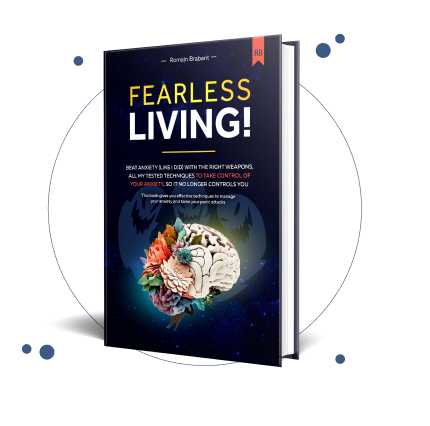
If you’ve ever wondered, “can anxiety cause nausea?,” the short answer is a resounding yes. It's not just in your head, and you are definitely not the only one dealing with this. The great news? There's a clear biological reason for it, and understanding that reason is the first step toward finding lasting relief and living a calmer, panic-free life.
The Unsettling Link Between Mind and Stomach
That queasy, churning feeling that shows up right before a big presentation or during a stressful argument isn't a coincidence. It’s a very real, physical response to what’s happening in your mind. The connection between your brain and your gut is incredibly powerful, and when anxiety revs up, it can throw your entire digestive system out of whack.
This isn’t just a rare phenomenon, either. Nausea is one of the most common physical symptoms of anxiety. In fact, a major study found that people with various types of anxiety disorders were over three times more likely to struggle with nausea than those without. The data is clear: when your mind is in turmoil, your stomach often feels it first. You can dig into the specifics of this Norwegian study to learn more about the strong connection between anxiety and nausea.
Before we dive deep into the science, let's look at a quick overview of the main culprits.
How Anxiety Triggers Nausea at a Glance
This table gives you a snapshot of the primary ways anxiety can make you feel sick. We'll explore each of these in more detail, but this is a great starting point for understanding what's happening inside your body.
| Mechanism | How It Contributes to Nausea |
|---|---|
| Fight-or-Flight Response | Diverts blood away from the digestive system, slowing it down. |
| Hormone Release | Adrenaline and cortisol flood your system, disrupting gut function. |
| Increased Stomach Acid | Stress can cause your stomach to produce more acid, leading to irritation. |
| Vagus Nerve Stimulation | This nerve connects the brain and gut; overstimulation sends distress signals. |
| Gut Microbiome Changes | Chronic stress can alter the balance of healthy gut bacteria. |
Seeing it laid out like this can be eye-opening. It's not one single thing but a cascade of interconnected biological responses.
Finding Hope in Understanding
Just knowing that your nausea has a name and a reason—anxiety—can be a massive relief. It means you’re not dealing with some mysterious, random illness. It validates what you’re feeling and, more importantly, gives you a clear target. Instead of feeling powerless against random waves of sickness, you can start connecting the dots between your stress levels and your physical symptoms.
The goal here isn't just to slap a bandage on the symptoms. It's to give you real, tangible hope for a calmer, more settled future. A life where you aren't held hostage by anxiety-induced nausea is absolutely possible, and it all begins with understanding why it happens.
Think of this article as your roadmap to freedom. We’re about to break down exactly how anxiety hijacks your digestive system and, most importantly, give you actionable strategies to take back control. Every bit of knowledge you gain is a step toward feeling more at ease in your own body and toward a future without panic.
Your Gut-Brain Axis: The Body’s Emotional Highway
Ever wondered why a wave of anxiety can make you feel sick to your stomach? It's not just a coincidence. Think of your brain and your gut as being connected by a busy, two-way superhighway. This isn't just a metaphor; it's a real biological network called the gut-brain axis, and it’s humming with constant communication.
This connection is the key to understanding why anxiety and nausea are such frequent partners.
When your brain picks up on a threat—it doesn't matter if it's a real danger or just an anxious thought—it sends out an immediate alert. These urgent messages travel down the highway, telling your digestive system to brace for impact. This rapid-fire communication can throw your gut's normal rhythm completely out of whack, leading directly to that familiar, queasy feeling.
The Two-Way Traffic of Distress
But here's where it gets tricky: the information doesn't just travel one way. An upset stomach, whether it’s from stress or something you ate, can send its own distress signals right back up to the brain. This feedback loop can crank up feelings of worry and panic, trapping you in a frustrating cycle where anxiety causes nausea, and the nausea then fuels even more anxiety. It's exhausting.
The infographic below shows just how powerful this connection is, illustrating how emotional signals from your brain have a direct line to your stomach.

Seeing this laid out makes one thing clear: this isn't random. It's a direct physiological pathway. Grasping this is incredibly empowering because it confirms your physical symptoms are real and rooted in your biology—they aren't just "in your head." More importantly, it gives us a clear roadmap for how to intervene and bring peace back to both your mind and your stomach.
Hormones and The Stress Response
So, how does anxiety actually flip the switch on nausea? When you feel anxious, your body kicks into its classic stress response, flooding your system with hormones like cortisol and adrenaline. These chemicals are designed to prep you for "fight or flight," but they also mess with your gastrointestinal motility and heighten your sensitivity to what's happening inside your body. That sudden hypersensitivity is often what you feel as nausea.
Breaking the Cycle is Possible: Recognizing this gut-brain connection is the first, most powerful step toward healing. It means you can take action to calm the entire system, not just one part of it. A calmer mind leads to a calmer gut, and a healthier gut can lead to a more peaceful mind. This is how you build a life free from panic.
This knowledge opens the door to strategies that actually work. By focusing on your gut health, you can directly influence your mental well-being. If you're looking for ways to support this crucial mind-stomach connection and fend off digestive issues, exploring practical tips to improve gut health is a great place to start.
Ultimately, healing from anxiety-induced nausea is all about nurturing this relationship. Our guide on https://anxietychecklist.com/lifestyle-diet-changes-anxiety-management offers more concrete steps you can take. You have the power to calm this emotional highway and find lasting relief.
How a Stressed Mind Can Upset Your Stomach
Ever notice how that pit in your stomach shows up right when you start to feel anxious? It's not a coincidence. When your brain registers a threat—whether it's a looming work deadline or a genuine physical danger—it doesn't stop to ask questions. It just acts, kicking its ancient "fight-or-flight" survival system into high gear. This response is automatic, powerful, and has a direct, immediate impact on your stomach.

The moment anxiety hits, your brain floods your system with a cocktail of stress hormones, mostly adrenaline and cortisol. Think of it as your body's internal emergency alarm suddenly blaring. These chemicals are designed to give you a quick burst of energy and strength, preparing you to either confront the perceived threat or run from it.
To pull this off, your body has to make a split-second decision about where to send its resources. It diverts blood away from functions that aren't critical for immediate survival—like digestion—and shunts it to your large muscle groups. While this is a brilliant evolutionary trick for escaping a predator, it brings your entire digestive process to a grinding halt.
The Perfect Storm for Nausea
This sudden biological shift creates the perfect storm for nausea inside your gut. With blood flow rerouted away from your stomach, a few things happen at once that directly lead to that queasy, sickening feeling:
- Digestion Slows Down: With less blood, your stomach stops its normal process of breaking down food. Things just sit there, churning uncomfortably.
- Stomach Acid Increases: At the same time, stress can ramp up the production of stomach acid, creating irritation and that familiar burning discomfort.
- Muscles Tighten: The muscles in your abdominal wall contract and tense up, which can feel like cramping, tightness, or a knot in your stomach.
This cascade of events isn't some random malfunction; it's a direct, physiological consequence of your body's stress response. Just understanding this connection is the first step toward feeling in control again. It demystifies the symptom, showing you that the nausea isn't a sign you're truly sick, but rather a predictable effect of anxiety.
Knowing this gives you power. It means that by managing your anxiety, you can directly calm your stomach. The nausea isn't a life sentence; it's a signal from your body that you can learn to interpret and respond to with confidence and hope.
Learning what sets off your body's alarm in the first place is a key part of this process. Recognizing your personal stressors and understanding the common anxiety triggers can help you anticipate and manage these physical reactions before they take hold. On top of the nausea, a stressed mind can also change your relationship with food. For anyone who eats differently under pressure, figuring out how to stop stress eating can be another important piece of the wellness puzzle.
The message here is one of profound hope. The link between your mind and your stomach is clear, which means the path to relief is also clear. By addressing the root cause—the anxiety—you can soothe the physical symptoms and move toward a life where you feel calm, settled, and in control.
Practical Strategies for Immediate Calm and Relief

When that familiar wave of anxiety-induced nausea hits, it can feel like your body has been hijacked. It’s an overwhelming sensation that robs you of your sense of control. In those moments, you don’t need complex theories; you need simple, powerful tools that work right now.
These strategies are more than just distractions. They are scientifically-backed methods designed to calm your body’s frantic alarm system and help you reclaim a sense of peace. Most importantly, they prove that you can take command, even when you feel completely powerless. Healing starts the moment you decide to respond to your body with intention instead of fear.
Ground Yourself in the Present Moment
Anxiety loves to drag your mind into a catastrophic future, but grounding techniques are your anchor to the safety of the present. They effectively break the cycle of "what if" thoughts that fuel physical symptoms like nausea. The 5-4-3-2-1 method is a fantastic tool for this because it forces your brain to engage with your immediate, tangible surroundings.
Here’s how it works:
- 5 Things You Can See: Slowly look around and name five objects. Notice their color, their shape, maybe a crack in the wall or the way light hits a surface. Don’t just glance; truly see them.
- 4 Things You Can Feel: Tune into the physical sensations right here, right now. It could be the texture of your jeans, the solid ground beneath your feet, or the cool, smooth surface of a table.
- 3 Things You Can Hear: Listen closely for three distinct sounds. It might be the low hum of a refrigerator, distant traffic, or the sound of your own breathing. Isolate each one.
- 2 Things You Can Smell: What scents are in the air? Maybe it's the faint aroma of coffee, a fresh breeze through an open window, or the soap on your hands.
- 1 Thing You Can Taste: Bring your full attention to your mouth. What can you taste? You could take a small sip of water or simply notice the neutral taste that’s already there.
This simple exercise pulls you back into the here and now, sending a powerful all-clear signal to your nervous system. It says, "You are safe." For more powerful exercises like this one, you can explore other grounding techniques for anxiety to build your personal go-to toolkit.
Harness the Power of Your Breath
Your breath is one of the most direct and effective tools for switching off your body's "fight-or-flight" response. When you’re anxious, your breathing naturally becomes shallow and rapid, which only intensifies the feeling of nausea. Slow, deep belly breathing—also known as diaphragmatic breathing—does the exact opposite. It activates your parasympathetic nervous system, your body’s built-in relaxation response.
Hope is a practice. Each deep breath is an act of self-compassion. Each moment you ground yourself is a step toward freedom. You are learning the language of your own nervous system, and with time, you can guide it back to a state of calm.
Imagine a dimmer switch for your anxiety. That’s what intentional breathing is. By practicing techniques like box breathing—inhaling for four seconds, holding for four, exhaling for four, and holding again for four—you can physically regulate your heart rate and settle your stomach. This isn't just a mental trick; it’s a physiological reset button you carry with you everywhere you go.
Long-Term Healing: Building a Panic-Free Life
While coping techniques are crucial for getting through a sudden wave of anxiety and nausea, the real goal is something much deeper. It’s about building a life where anxiety doesn’t call the shots. This is a journey of healing from the ground up, creating long-term resilience so you can finally live a panic-free life.
This isn't about just "managing" forever. It’s about fundamentally changing your relationship with anxiety, fortifying your body and mind so you're less susceptible to the triggers that once sent your stomach into a tailspin. Think of it as reclaiming control, one step at a time.
Fortifying Your Mind and Body
Building true resilience starts with small, consistent lifestyle shifts that have a massive cumulative effect on your nervous system and gut health. These aren't quick fixes; they're powerful investments in your long-term well-being.
- Nourish Your Gut-Brain Axis: A balanced diet rich in whole foods, fiber, and probiotics is a game-changer. It supports a healthy gut microbiome, which is in constant communication with your brain. A calmer gut really can lead to a calmer mind.
- Embrace Mindful Movement: Regular physical activity—whether it's brisk walking, yoga, or running—is an incredibly powerful tool. Exercise helps burn off excess stress hormones like adrenaline and cortisol, quieting the "fight-or-flight" response that so often ends in nausea.
- Prioritize Restorative Sleep: For an anxious nervous system, a consistent sleep schedule is non-negotiable. Quality sleep helps regulate your mood, dials down stress hormones, and gives your body and mind the time they need to repair and recover.
Rewiring Your Thoughts with Professional Support
Lifestyle changes create a strong foundation, but sometimes, we need help to untangle the very thought patterns that fuel anxiety. This is where professional support can be absolutely life-changing, offering a clear path toward healing.
Anxiety is a widespread issue, affecting an estimated 4.05% of the global population, yet so many people don't seek help. Part of the problem is that they don't realize physical symptoms like nausea are classic signs of an anxiety disorder. You can read more about these global mental health findings and treatment gaps to understand the scale of the issue.
Hope in Action: Therapy isn't about dwelling on problems; it's about actively building solutions. It equips you with the tools to understand your own mind and gently guide it toward new, healthier patterns, proving that a panic-free life is absolutely within your reach.
Cognitive Behavioral Therapy (CBT) is a highly effective approach that helps you identify, challenge, and reframe the negative thought cycles that trigger both the anxiety and its physical symptoms. Another powerful method is exposure therapy, which helps you gradually and safely face your fears. You can learn more about how exposure therapy for anxiety works in our detailed guide.
Ultimately, these strategies empower you to dismantle the very core of your anxiety, one thought at a time.
Your Questions About Anxiety and Nausea, Answered
Feeling sick from anxiety can be incredibly confusing and distressing. Let's tackle some of the most common questions people have. Getting clear answers is often the first step toward feeling in control again.
Knowing you have tools to manage these physical symptoms can build incredible confidence on your path to wellness.
What Does Anxiety Nausea Actually Feel Like?
Anxiety nausea often shows up as a churning or tightening in your stomach. For some, it feels like a lump in their throat or just a general, nagging sense of unease.
The biggest giveaway? Unlike a stomach bug, it’s directly tied to moments of high stress or worry. It can appear suddenly and fade just as quickly as your emotional state changes, often without any other signs of actual illness. This direct link shows your body is responding to your thoughts. Recognizing this pattern is empowering—it means that by calming your mind, you can directly soothe your stomach.
Hope begins when you realize the nausea isn't a random illness but a signal you can learn to manage. A life free from this symptom isn't just a dream; it's an achievable goal, built one step at a time through consistent practice and self-compassion.
Can I Really Stop This Feeling for Good?
Yes, it is absolutely possible to significantly reduce and even eliminate anxiety-induced nausea. Healing is a journey, not an overnight fix, but you have immense power to change your body’s response to stress.
By using the immediate relief techniques and long-term strategies we’ve discussed, you can retrain your body's "fight-or-flight" reaction. You are fully capable of rewiring your brain’s response to whatever triggers your anxiety. With consistent practice and the right support, you can build a life where anxiety no longer dictates how you feel physically. You can live panic-free.
This process is about more than just coping; it's about deep, lasting healing. Every small victory builds momentum, proving that you are in control. A peaceful, settled stomach and a calm mind are well within your reach.
The Anxiety Checklist offers a complete, self-guided system to help you move from merely coping to truly healing. Our practical tools and cognitive strategies empower you to dismantle anxiety's hold on your life. Start building your fearless future today at https://anxietychecklist.com.

